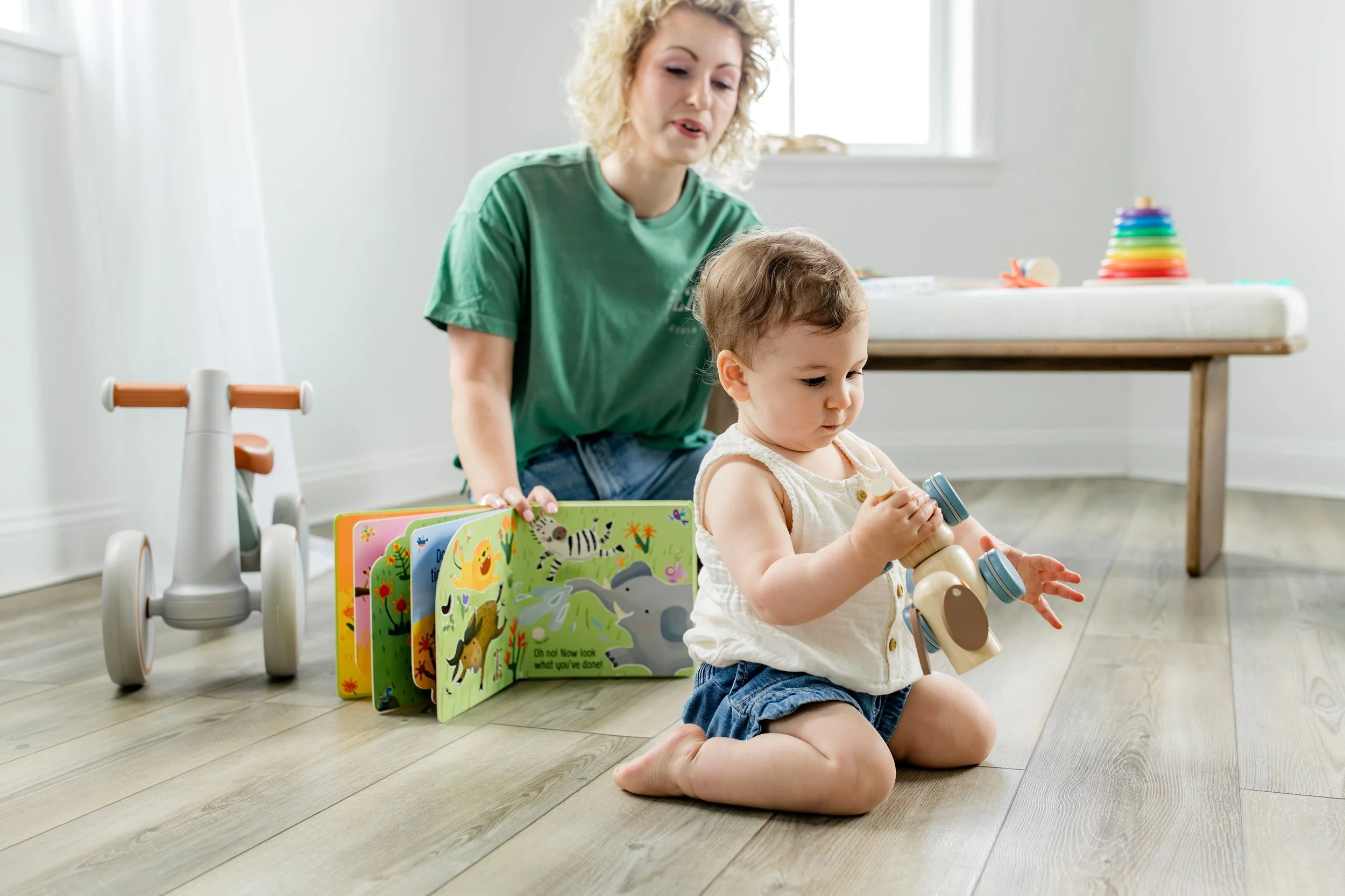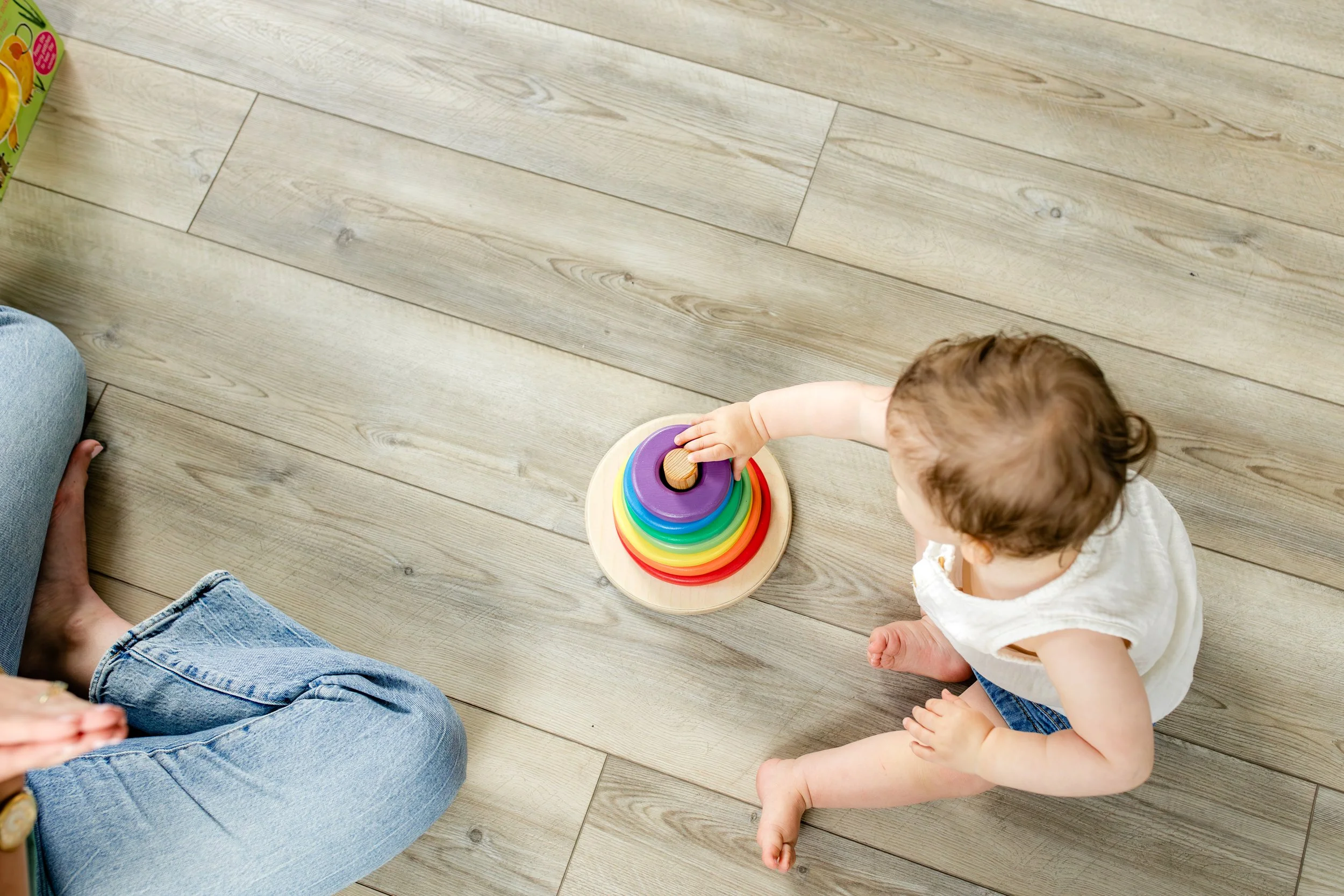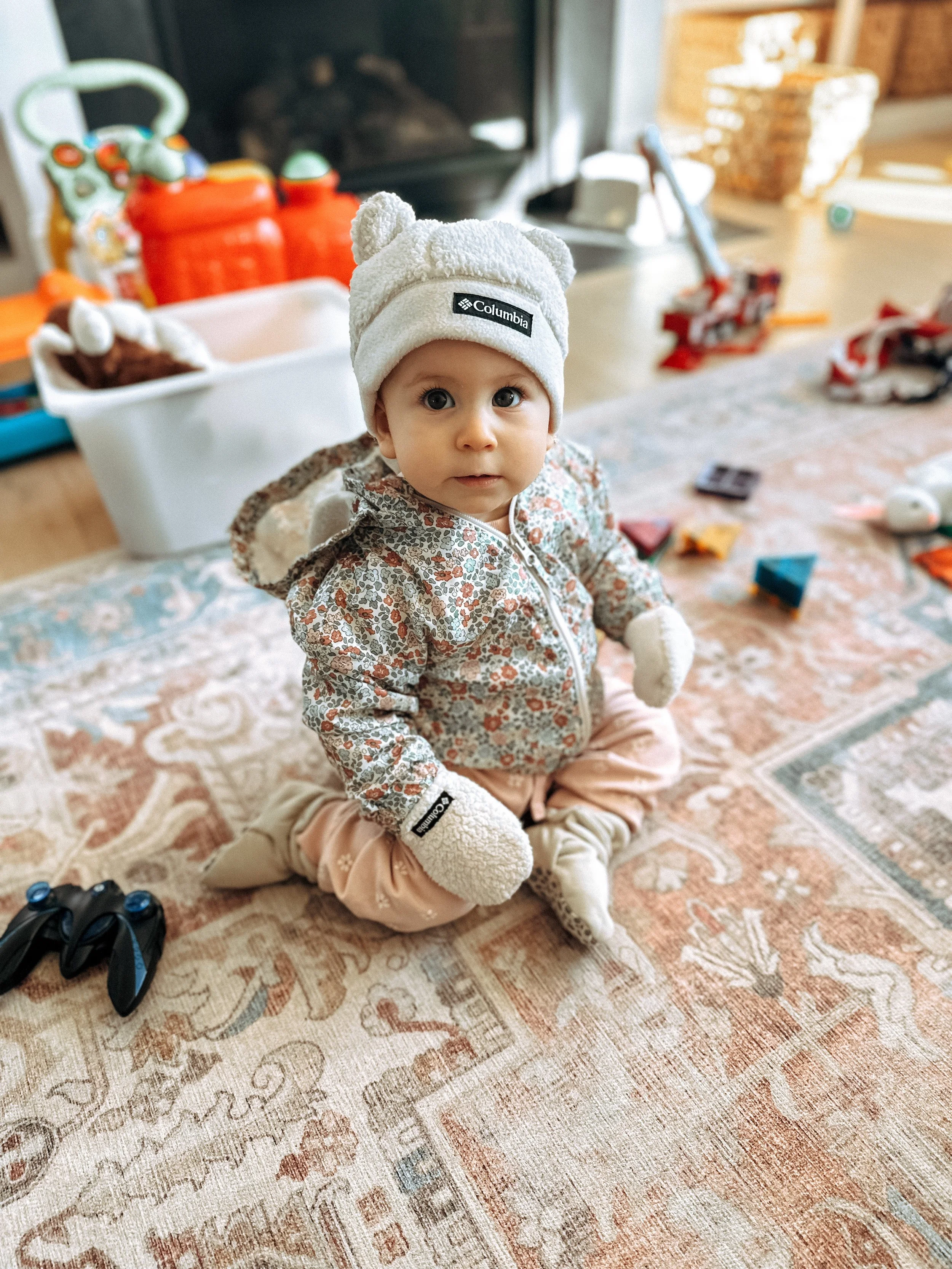What is W Sitting?
This page contains affiliate links. We will receive a commission on qualifying purchases using these links.
Maybe you have seen warning signs on the internet about not letting your little one stay in a W sitting position. Or maybe you have been told by a medical professional to “fix the legs” when you see your infant W sitting, but you have no idea why. Well, the good news is that we are here to answer all of your W sitting questions! Our Pediatric Occupational Therapist, Olivia, is breaking down all you need to know and starting with a very important question…
You can see Penelope here W Sitting at around 14-months-old.
What Does W Sitting Look Like?
W sitting (also known as W-shaped sitting and television sitting) is when a little one sits on the floor in a position that, from overhead, looks like a “W”. Their bottom is touching the floor while their left knee is bent and touching the ground on the left side of the body, and the right knee is bent and touching the ground on the right side of the body, similar to this baby in the picture below.
Is W Sitting Bad?
So, what’s the big deal? Why do we even care if our little one is sitting like this? Truth be told, it actually isn’t so much about the sitting position at all. Say it loud and proud… it’s all about that back (and core)!
When a little one is engaging in W sitting, instead of rushing over to “fix their legs” or maneuver them out of the position, sit back and take a look at three things:
What does their back look like?
Are they sitting up straight (like the baby pictured above), engaging their back and core muscles? Or are they slouched over, almost sinking down into the W sitting position with their pelvis jutted forward. If their back is curved, it could be a sign that the little one is sitting without the use of their core muscles.
The W position of the sitting posture can become a preferred sitting posture for a little one because it essentially widens their base of support and allows them to sit without using their back or core muscles.
Try it! If you sit on the floor in a criss-cross applesauce position (you know exactly what position we mean, don’t you?!), you will feel how easy it is to stack your tummy over your pelvis and sit up straight (engaging those back and core muscles). Now, spread your legs out as wide as you can, and notice how much easier it is to slump down and slouch.
When we have a wider base of support, we do not have to work as hard. Little ones are smart and they can figure this out too! So watch that back!
Are they staying still or are they moving around?
Truth be told, a lot of kiddos will transition in and out of W sitting positioning as they are moving around and playing on the floor.
They might go from side sitting, to W sitting, to up to high kneeling, then back down to their bottom with legs out in front of them (like the baby pictured below). This type of movement when sitting is called “dynamic sitting” and is perfectly normal for toddlers to engage in. They are actually heavily relying on their back and core muscles to help them move around in these positions.
On the other hand, if a little one is only sitting in the W sitting position for an entire play series (think several minutes or with several toys), they may be finding ways to get out of having to use their core and back muscles. We would call this a “static sitting” posture, meaning they essentially seem “stuck” in this one sitting position.
Are they engaging in symmetrical crawling?
Symmetrical crawling (alternating left/right hands and knees evenly) is typically a good sign that your little one is using their back and core muscles appropriately. If you notice butt scooting, hitch crawling, any other ‘funky’ crawling with your little one, or your little one is not interested in crawling at all (we like to see littles on engaging in symmetrical crawling no later than 10 months), this may be a sign they are getting around using their back and core muscles. Our crawling blog has many great tips if you need them!
How Can I Help Fix W Sitting?
If you notice that your little one is hunched over with a rounded back or “stuck” in W sitting, remember that your little one is trying to get out of using their core and back muscles, so simply “fixing their legs” (repositioning their legs out of W sitting) is not “cure all” for helping them to evolve out of W sitting.
Play Positions to Strengthen Back & Core Muscles:
High Kneeling:
There is no way to sneak out of using the back and core muscles when we are in high kneeling (kneeling with both legs parallel to each other and knees directly under hips) so this a great position to help get out little one to play in. You can have them kneel at an activity table and engage with the buttons and fidgets on the table, kneel in front of a body mirror with both hands flat on the mirror to help them support themselves (these suction spinners are my favorite for this), or kneeling in front of a toy bin/laundry basket, or empty diaper box to pull things out of or put things back in box.
Side Sitting:
Also called the “cheerleader pose”, this sitting position happens when the little one’s bottom is touching the floor and both of the knees are tucked but facing the same (as opposed to w sitting where the legs are going opposite directions like W sitting). Place a favorite toy to the left or right side of your little one and help your little one lean to that side to engage with it while they engage in side sitting (their legs should be pointing the opposite way they are leaning (as pictured below). Again- this positioning is impossible to maintain without the use of the back and core muscle, as will help your little one get comfortable moving around in sitting with their hands touching the floor. You can also use a slanted surface like the front of a walker for this kind of play!
Prop Up That Butt:
Place a pillow under your little one’s tail bone to straighten their legs out in front of them. This is a perfect time to read a book together! Hold the book up at eye level so you little one is encouraged to sit up taller. By lifting the butt up a little bit, we are forcing the core muscles to engage!
90-90-90 Sitting:
Grab a step stool and bring it out to your play area. Help your little one sit on the step so that their feet are flat on the ground and their knees are bent to 90 degrees. Again, placing them in front of a mirror, playing with a toy at eye level, or reading a book at eye level are perfect activities to do with your little one while they are in this position.
A W Sitting Position is Not Bad
Lastly, The International Hip Dysplasia Institute has debunked the myth that W sitting is bad by stating, “This way of sitting … is often noticed around the age of three years while the child is very flexible. During further growth, the bone twist goes away naturally in 99% of children without intervention. When this goes away, parents and doctors often credit whatever they did to “help” it go away. Studies have shown that W-sitting does not cause any harm to the developing hips, and does not contribute to hip dysplasia.”
So, no, don’t freak out if you’re noticing your little one W sitting here and there. Take into account their play positions as a whole, and then decide if they need some support or help in the area of core strength! Our blogs about helping baby stand and walk also provide great tips for helping baby move comfortably and meet their gross motor milestones.
When to Contact Early Intervention
In some cases, just helping your little one get into these different sitting positions can be very challenging. If your little one is not crawling, has an atypical crawling pattern, or is having a hard time trying the play positions listed above, it may be a sign that they have some underlying difficulties such as overall weakness, low muscle tone, or unintegrated primitive reflexes, which may be related to their W sitting. Reach out to your state’s Early Intervention Program for an OT or PT evaluation, or you can chat with one of our specialists.
Looking for More?
Have more questoins about baby & toddler development? We have you covered!






